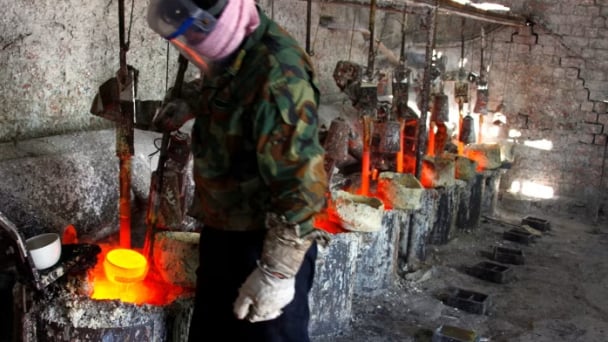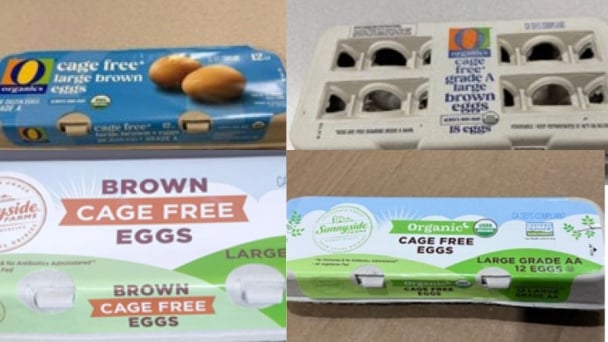June 16, 2025 | 04:13 GMT +7
June 16, 2025 | 04:13 GMT +7
Hotline: 0913.378.918
June 16, 2025 | 04:13 GMT +7
Hotline: 0913.378.918
Soft to touch and just 1.3 centimetres in size, these robots already suck up microplastics in shallow water.
The team aims to enable them to collect microplastics in deeper water and provide information to analyse marine pollution in real time, said Wang Yuyan, one of the researchers who developed the robot.
"We developed such a lightweight miniaturised robot. It can be used in many ways, for example in biomedical or hazardous operations, such a small robot that can be localised to a part of your body to help you eliminate some disease."
The black robot fish is irradiated by a light, helping it to flap its fins and wiggle its body. Scientists can control the fish using the light to avoid it crashing into other fish or ships.
If it is accidentally eaten by other fish, it can be digested without harm as it is made from polyurethane, which is also biocompatible, Wang said.
The fish is able to absorb pollutants and recover itself even when it is damaged. It can swim up to 2.76 body lengths per second, faster than most artificial soft robots.
"We are mostly working on collection (of microplastics). It is like a sampling robot and it can be used repeatedly," she said.
Where Are Microplastics Found in the Ocean?
Microplastics can be found virtually anywhere throughout the ocean, including its surface and the floor. However, the majority of these plastics are found on the surface.
Surprisingly, 92% of plastic pollution found on the ocean’s surface is microplastic. Studies have also found the concentration of microplastics on the ocean floor to be increasing as well.
Why is Microplastic So Dangerous to our Oceans?
So, now that we know what they are, why are microplastics so dangerous? Well, much like other forms of plastic pollution, microplastics pose threats to marine organisms and the environment.
Microplastics can cause many issues for aquatic life. Similar to other foreign materials that are found in the ocean, microplastics can be consumed by animals by mistake.
This can create direct and indirect threats for sea creatures. As you may know, the ingestion of plastic particles is not healthy for animals and can lead to severe health consequences including death.
However, if the microplastic does not kill marine life it can lead to cuts or damage of the internal organs and tissues. Further, it can limit their ability to reproduce, resulting in smaller populations.
Additionally, microplastics can also get into an animal’s system simply through their breathing process.
Due to the small size of the particles, this debris can get stuck in the gills of some marine life. On the other hand, even the animals who don’t consume microplastics may suffer.
This is because if an animal at the bottom of the food chain eats some of this debris, the material will continue to pass through the systems of each animal in that food chain. Simply put, animals who haven’t even consumed microplastic themselves could die.
In addition to all of this, microplastic allows small invasive species to spread much more efficiently. Invasive species can completely wipe out other species and lead to the absolute destruction of marine environments.
If our marine ecosystems collapse, it is likely the rest of the environment will suffer as every living creature plays a part in making things run smoothly.
(Reuters; Americanoceans)

(VAN) Extensive licensing requirements raise concerns about intellectual property theft.

(VAN) As of Friday, a salmonella outbreak linked to a California egg producer had sickened at least 79 people. Of the infected people, 21 hospitalizations were reported, U.S. health officials said.

(VAN) With the war ongoing, many Ukrainian farmers and rural farming families face limited access to their land due to mines and lack the financial resources to purchase needed agricultural inputs.

(VAN) Vikas Rambal has quietly built a $5 billion business empire in manufacturing, property and solar, and catapulted onto the Rich List.

(VAN) Available cropland now at less than five percent, according to latest geospatial assessment from FAO and UNOSAT.

(VAN) Alt Carbon has raised $12 million in a seed round as it plans to scale its carbon dioxide removal work in the South Asian nation.

(VAN) Attempts to bring down the price of the Japanese staple have had little effect amid a cost-of-living crisis.